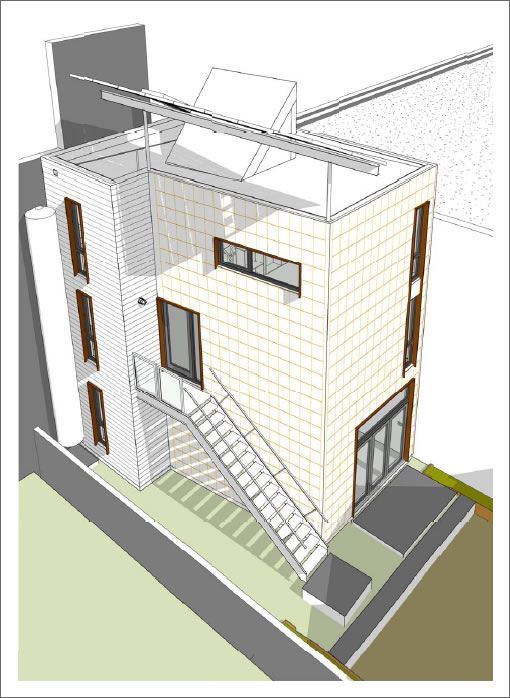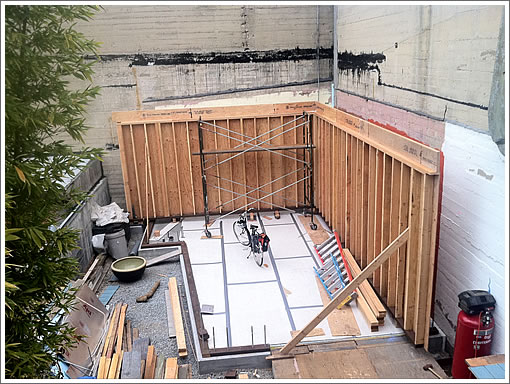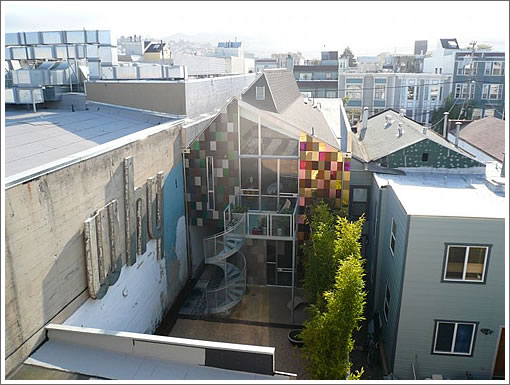
The goal, to build the first “Net Zero Energy, LEED Platinum, Green Point Rated, Living Building Challenge Certified, PassivHaus Certified Residence in San Francisco.”

The approach, a three story addition designed by David Baker + Partners and dubbed the ZeroCottage to built on the lot behind the existing dwelling at 337 Shotwell, which some might recognize as the residence of the architecture firm’s namesake.

∙ 339 Shotwell ZeroCottage: Construction Drawings [dbarchitect.com]
∙ ZeroCottage Blog [zerocottage.net]

Baker rocks. Wish we could afford to hire him for our place.
This looks great. I bet he’s happy that some work is finally getting done on the burnt out building on the corner.
He talks down to people.
Really have to admire the transparency – posting the complete set of plans on line, helping others who may want to adopt some of these ZNE strategies.
Cool! I really like this neighborhood too. Not sure I would want to live there, though.
The goal, to build the first “Net Zero Energy, LEED Platinum, Green Point Rated, Living Building Challenge Certified, PassivHaus Certified Residence in San Francisco.”
‘The nice thing about standards is that there are so many to choose from.’
So ugly.
Anybody know what the three-story cylinder at the back of the building is? It appears and disappears in various renderings. Water storage?
And I’m not complaining, but rear-yard rules??? Do you get a variance if the rear yard is already walled in?
^ “our hope to attach this 3’ diameter by nearly 30’ tall taank to the side of our building in hopes to capture as much rainwater as possible from the roof.”
“Our rainwater system will consist of the following components:
■Debris Filter- This is exactly as it sounds. It could be some sort of screening device that removes large debris from the water as the water flows into the downspout.
■Downspout Filter- We will use a WISY residential downspout filter which cleans out smaller debris and is real necessity before allowing the water into the cistern. At this point, in my estimation, the water is ready to be used for irrigation. Some may want to take this a step further and use a floating extractor are even treat the water chemically, however this is up to your discretion and the discretion of any governing codes.
■Water Pump- If you’re looking into using the water inside your house then the next step is building up enough pressure with a water pump. Rainwater, can often be used not only to irrigate, but also to flush toilets.
■Reverse Osmosis Filters and UV Light- The next step to bring the water back in might involve more filtration to assure that bacteria is completely killed, and this is achieved through R.O. Filters, and a U.V. Light.
■Backflow Preventor- The final step before entering the system is a backflow preventor which is required to insure that the domestic water supply will not be contaminated by the rainwater in any way.
By far, the most bang for our buck is to simply stop at irrigation, and provide low flow toilets within the cottage. The cistern will get a 1/2” spigot and will be used for irrigation only, and the planting is drought tolerant. This means that even in California, where we often don’t see rain for seven months, we should be able to provide a lush garden all year round with no municipal water.”
Is it legal to collect rainwater in CA?
why is it so big?
Yes, why does David insist talking down to people?
Surely his IQ divided by his ego is less than one, or is it the “prophet crying in the wilderness” syndrome? We hear ya David. Please save the world, but chill a bit, no whinning allowed!
@EH “Is it legal to collect rainwater in CA?”
The law is ambiguous. That’s why Assemblyman Jose Solorio introduced AB 275 to explicitly legalize rain water collection in California. The bill passed several committees and the Assembly. It’s currently on the floor in the Senate.
Is it legal to collect rainwater in CA?
Never heard of this. Can anyone explain what the reasoning behind such a law is?
I know several people who collect rainwater from their roof for their garden.
“Can anyone explain what the reasoning behind such a law is?”
I don’t know for sure, but my guess would be that if the collection is done improperly, you can have problems with mildew, mosquitoes, leakage, plumbing, overflow, etc. I don’t know of any California laws that prohibit it, but there may be permitting requirements if you have a larger system. For example, here are the requirements in the People’s Republic of Berkeley:
http://www.ci.berkeley.ca.us/ContentDisplay.aspx?id=45768
Filters, pumps, UV lights, a giant tank, etc. This seems like about the most cost- and energy-inefficient non-green means of providing water for a garden that I can imagine.
You wanna be green? Use the economies of scale and efficiencies of SF PUC and plant a garden that does not need much water.
Use the economies of scale and efficiencies of SF PUC and plant a garden that does not need much water.
Or plumb in a system for greywater recycling.